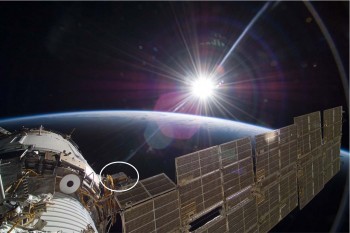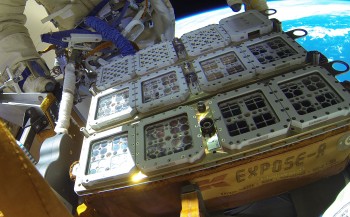While Tim Peake is inside the International Space Station, a number of hitchhikers have been flying with him – bolted to the outside! ESA has been sending facilities into space to see how materials react for many years. Exposing organisms and molecules the full blast of the Sun’s rays is impossible to do on Earth as our atmosphere protects us from solar and cosmic radiation. The latest facility, dubbed Expose-R2, contains samples from many groups of scientists throughout Europe and will return inside after the spacewalk on 3 February. We asked principle investigator Jean-Pierre de Vera from the German Aerospace Centre, DLR, to introduce the BIOMEX experiment that is part of Expose-R2:
BIOMEX is an ESA, DLR, ASI and INTA-supported space experiment that is part of Expose-R2 on the International Space Station. The experiment is trying to find answers to what are the limits of life and if it is possible that life could have travelled between planets or other objects (Lithopanspermia). We are looking at how stable bio-molecules are when subjected to simulated space- and Mars-like conditions on the outside of the International Space Station. In addition we are seeing how we can detect the organisms after their trip in space, and testing the limits of biofilms to form, in particular biofilms used in probiotic drinks which can trigger positive reactions in the immune system such as Kombucha which might be useful for maintenance of astronaut’s health.
If we find clear ways to detect changes in the bio-molecules this research will support Mars exploration. The ‘biosignatures’ will give future missions a reference data base to look for signs of life on the red planet. Side products of this project can be also used in archaeology, medicine and biotechnology.
During the last spacewalk to retrieve the Expose-R2 facility 3 February, pictures of the samples and compartments will be taken by the astronauts.
A cover will be placed on the sample box. The samples have to be carefully taken from the EXPOSE-R2 facility in the original compartments without contaminating them. Inside the International Space Station the astronauts will take pictures of the compartments and the samples again before packing them for the travel back to Earth.
Once on Earth the BIOMEX samples will be transferred to the DLR-site in Cologne, Germany, and sent to the institutes that worked on the project including our DLR-Institute of Planetary Research in Berlin. The institutes will check the vitality of organisms, the shape of the bio-molecules and analyse any damage to the DNA of the samples.
Watch the spacewalk live here from 12:30 GMT on Wednesday 3 February with the spacewalk planned to start at 13:10 GMT:



Discussion: no comments